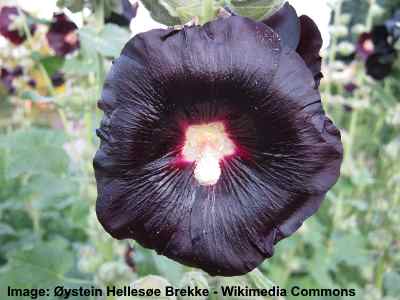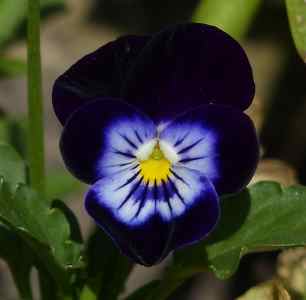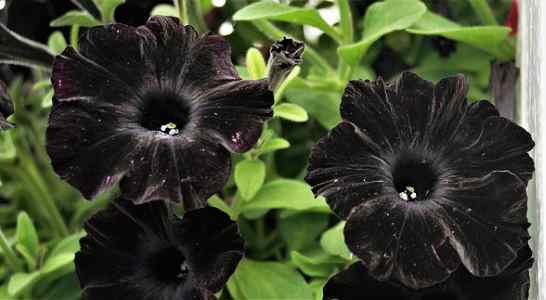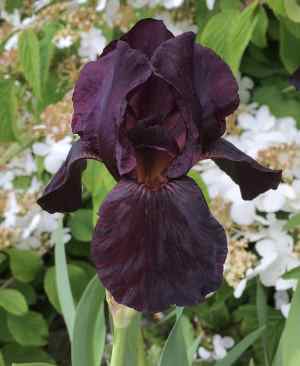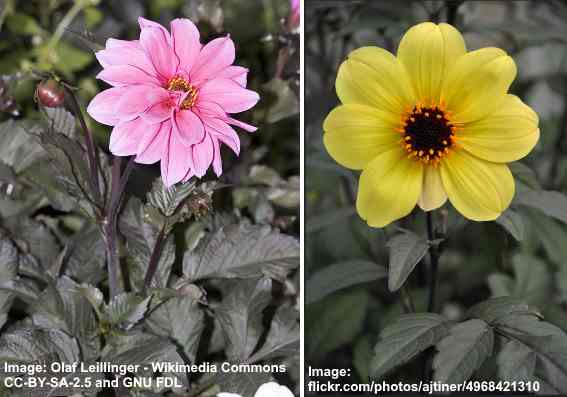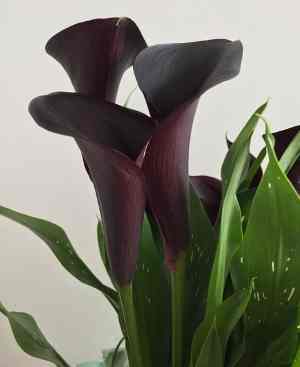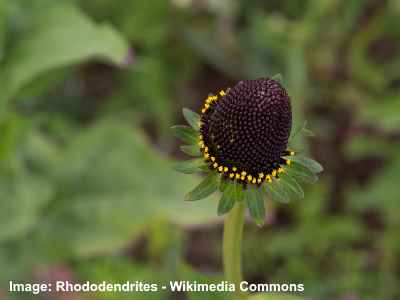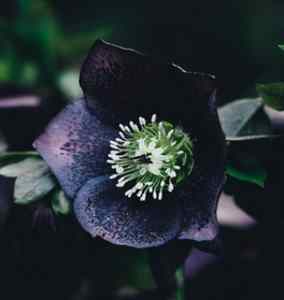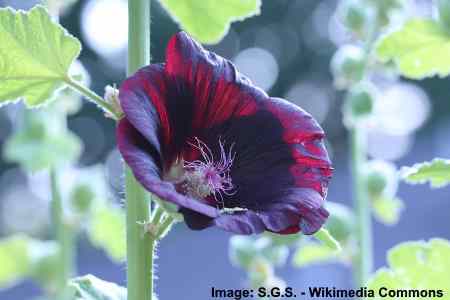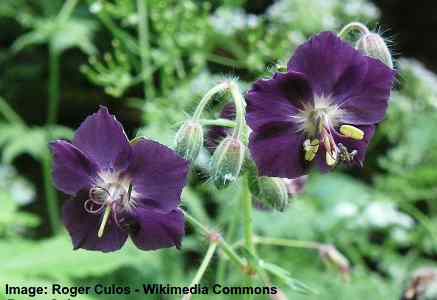Magnificent Types of Black Flowers with Pictures and Names
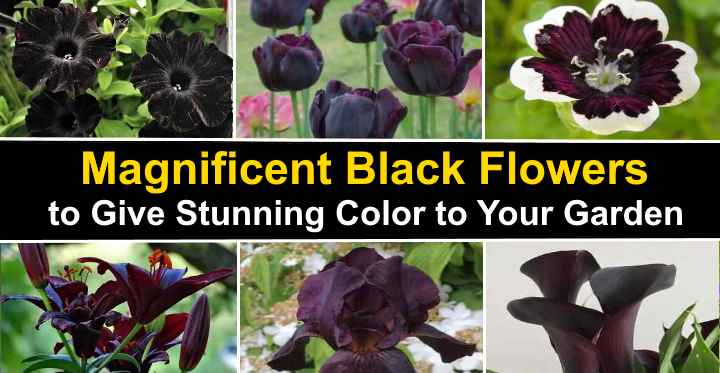
Black flowers are some of the most unusual types of flowers you can grow in your garden. Flowers that appear completely black are usually not truly black but they have such deep hues of blues, browns, purples, or reds that they appear black. The almost jet-black blossoms can look stunning against other brightly-colored flowers. Pitch-black flowers can also add a striking appearance to cut flower arrangements.
Most types of black flowers are cultivars of well-known species of flowers. Although it is rare to see truly black petals, some popular dark or almost black flowers include black pansies, tulips, lilies, dahlias, and roses. There are also flowers such as nemophila with fascinating black and white flowers. Some types of flowers such as petunias have black petals and contrasting yellow petals to create a truly striking appearance.
Because pure black flowers are so rare, they have come to symbolize mystery, elegance, or feeling somber. In some cases, a black flower could mean sadness if a friend is leaving. Or, a single black flower such as a rose or tulip along with a kind gift could signify a mysterious romantic interest.
The instructions for growing black flowers are the same as for most flowering plants. Most of them need to be in sunny areas of the garden, either in full sun or where there is partial shade. Generally, plants with dark flowers need well-drained soil the same as for most flowering annuals or perennials.
In this article, you will learn about the most fascinating black flowers to add intrigue to your garden or floral displays.
Are There True Black Flowers in Nature?
There are no true or completely black flowers that grow naturally in nature. Black pigments used to color petals and foliage don’t occur in plants or flowers. Usually, dark flowers that look black or very dark are the result of careful breeding and cultivating.
According to scientific research, dark/black flowers occur due to increasing the intensity of naturally-occurring chemicals called anthocyanins. These pigments can be red, purple, or blue. So, by careful selective breeding of flower species that have high levels of anthocyanins, flower breeders can grow flowers that appear black. (1)
For example, scientists found that the popular black flower Alcea rosea ‘Nigra’ contains 9 different anthocyanins to create the black flower color.
Types of Black Flowers (With Pictures and Common Name)
Although no real black flowers grow in nature, there are many beautiful examples of flowers with black or dark purple blooms. Here are some of the most sought-after black flowers.
‘Black Beauty’ Pansy
Pansies (genus Viola) are some of the prettiest flowers you can grow, and there are also some fascinating black cultivars. The darkest of the pansy cultivars are the ‘Black Beauty’ pansy and the ‘Black Magic’ flowers.
These annual spring-flowering plants have papery black petals that can look stunning against light backgrounds or planted together with yellow or white pansies.
‘Black Beauty’ pansy flowers have very dark, almost pure black petals with a beautiful sheen. Their beauty is enhanced by the bright yellow center in the middle of the flower.
‘Black Magic’ pansies are an outstanding example of a spring annual with black petals. The gorgeous black flowers have light sky-blue/purple coloring towards the center with a beautiful yellow middle.
‘Black Cat’ Petunia – Black Petunia Flower
There are a few types of petunia flowers that have deep purple or black petals. Belonging to the family Solanaceae, petunias produce a bushy mass of beautiful flowers that last from early spring until fall. Petunias also come in almost every shade of color from purple to cherry red, yellow, and lilac.
The ‘Black Cat’ petunia flower cultivar has velvety black petals that have striking appearance against its light-green foliage.
The ‘Black Velvet’ variety of petunia is a flower with very dark purple petals. Some of the purple hues are so deep that they look jet-black, especially in the center of the trumpet-shaped flower.
‘Queen of the Night’ Tulip

The elegant ‘Queen of the Night’ tulip flower has deep purple (almost black) color. It will give a dramatic look to any garden
Tulips (genus Tulipa) in the flower family Liliaceae are the classic spring flowers. Considered as one of the prettiest flowers in the world, tulips have come to symbolize love, forgiveness, and cheerful thoughts. The most popular type of black tulip flower is the ‘Queen of the Night’ cultivar.
The ‘Queen of the Night’ tulip is a late-flowering tulip cultivar that has large deep purple (almost black) cup-shaped flowers on the end of a long stalk. Although this is not a truly black flower, the ‘Queen of the Night’ is one of the closest to black tulips you will find. When the tulips flower in April and May, you are assured of a dramatic show of black flowers in among beautiful green foliage.
Black Bearded Iris Flowers
There are a number of bearded iris cultivars that have dark purple to black flowers. When planted among pastel-shaded irises, the effect in your garden can be truly outstanding. Bearded irises are some of the showiest perennials that are easy to grow and give off a wonderful fragrance.
Here are a few of the exceptional varieties of black irises, some with really black flowers.
‘Before the Storm’ Iris. The black iris ‘Before the Storm’ is described as one of the blackest iris flowers you can buy. The ruffled petals of the flower look truly black and sit on top of long 31” (92 cm) stems. One of the fascinating features of ‘Before the Storm’ irises are the heavenly fragrance the black flowers give off.
‘Men in Black’ Iris. Depending on the light, the dark purple petals of ‘Men in Black’ irises look like real black flowers. The eye-catching dark flowers are enhanced by a mustard-yellow beard in the center of the blossoms.
‘Winesap’ Reblooming Bearded Iris. This black iris species provides wonderful dark wine-red colored flowers when it flowers between spring and fall. This perennial blooms every year and adds dramatic dark colors and sweet fragrances to your garden.
‘Old Black Magic’ Bearded Iris. This spring perennial black iris gives off sweet scents and looks amazing against its sword-shaped green foliage. These delightful black plum-colored flowers can add an element of mysteriousness to purple and black flower bouquets.
Black Dahlia Flowers

Some dahlia cultivars have dark red or deep burgundy flowers. Left: ‘Arabian Night’, right: ‘Chat Noir’
Black dahlias are not true black flowers but types of dark red or burgundy blooms that have an almost black appearance.
Dahlias are well-known for their showy displays of large flowers in various forms and shapes. All types of dahlias belong to the family Asteraceae which means they are related to asters, chrysanthemums, and daisies. Dahlias are perennials that bloom throughout the summer and into late fall.
There are two main types of dahlias that are considered black dahlias:
The ‘Arabian Night’ dahlia has large double dark flowers that grow up to 4” (10 cm) wide. These beautiful flowers have a dark red and black appearance, especially the curved petals near the center. These dark red flowers that almost look black make for stunning centerpieces in any floral display.
The ‘Chat Noir’ dahlia is also black-looking due to the dark hues of burgundy on the petals. The large spiky-looking flowers can grow up to 8” (20 cm) across and are made up of black and red velvety petals.
Dahlias with black foliage
To add an air of intrigue to your garden, you can also grow dahlias that have black leaves. These unusual and unique plants have dark foliage that provides a stunning contrasting backdrop for red and pink dahlia flowers, as well as orange, yellow, and white varieties.
Dahlia cultivars with black foliage include ‘Bishop of Auckland,’ ‘David Howard,’ Fascination,’ and ‘Happy Single Party.’
‘Odessa’ and ‘Black Forest’ Calla Lily (Zantedeschia)
With their black, trumpet-like flowers, certain species of calla lilies (Zantedeschia) make a strong statement. The Zantedeschia ‘Odessa’ is a type of calla lily with almost-black purple flowers. The elegant dark flowers sit among green leaves shaped like arrowheads. The leaves of this ‘black’ calla lily cultivar may have white speckles on them.
Another similar-looking calla lily hybrid is the ‘Black Forest.’ These funnel-shaped flowers are also almost black due to the deep purple hues.
Calla lilies are great for border plants or growing in containers. Grow these black varieties alongside white calla lilies for an outstanding black and white floral display in your garden.
‘Green Wizard’ Coneflower
Rudbeckia occidentalis is the botanical name for a species of black flowering plant called the Western Coneflower. The unusually-looking flower heads of these coneflowers are a large acorn-shaped flower that is a purple-brown color. Against the green foliage, this purplish flower looks completely black.
Some types of Wester Coneflowers such as the ‘Green Wizard’ and the ‘Black Beauty’ have tiny yellow pollen spots around the base.
The more well-known varieties of coneflowers are the yellow ‘Black-Eyed Susans’ and the purple flowers of Echinacea plants.
Bat Orchid
The black bat flower must be on the list for one of the most unusual plants that you will come across. The bat orchid (Tacca chantrieri) is a tropical plant native to Southeast Asia and has black flowers that grow up to 12” (30 cm) across.
The black bat orchid gets its name from the way it resembles a bat in flight. The unusual look of its real black flowers is enhanced by the long drooping whiskers that measure up to 28” (71 cm) long. The interesting thing about this cool flowering plant is that its flowers are almost naturally black without any special cultivation.
‘Black Charm’ Asiatic Lily
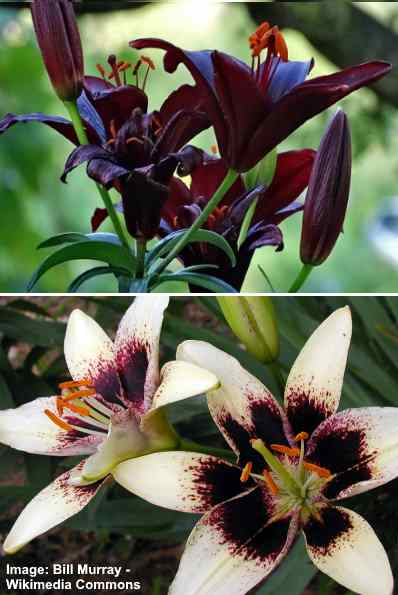
‘Black charm’ lily (upper picture) has dark red and black flowers. The ‘Black Spider’ (lower image) has white and almost black petals
Lilies come in many colors including pink, white, red, and even black. There are thousands of species of true lilies in the genus Lilium and family Liliaceae. Lily hybrids are famous for their tall height, showy trumpet-shaped flowers, and intense fragrances.
One of the most dramatic-looking lilies is the ‘Black Charm’ Asiatic hybrid. This fragrant lily has been bred to have intensely-colored dark burgundy petals that look almost pure black. Even the stamens and filaments in the center of the trumpet head are black-looking. The black-red flowers can create a dramatic floral bouquet when combined with white, yellow, or pastel shades of flowers.
The ‘Black Spider’ lily is another lily hybrid that has dark red-black coloring on its leaves. Dark burgundy, almost black colors are at the center of creamy-white petals creating an outstanding summer floral display.
‘New York Night’ Hellebore – Black Flower With Creamy Yellow Center
Lenten rose is another name for hellebore which is a genus of plant in the family Ranunculaceae. There are many species of Helleborus orientalis that flower in spring. While the most common colors of hellebores are pink, white, or lilac, there are also some cultivars with magical black flowers.
With its jet-black petals and creamy yellow center, the hellebore ‘New York Night’ is a spectacular flower. These black-purple single flowers are made up of 5 large petals measuring up to 3” (7.6 cm) across.
‘Blacknight’ Hollyhock (Alcea Rosea)
Hollyhocks (Alcea Rosea) are a bushy type of perennial or annual plant that produce a mass of flowers in spring and summer. The black varieties have dark black-like funnel-shaped flowers with brightly-colored centers.
The 2 outstanding black cultivars in the genus Alcea are ‘Blacknight’ and ‘Nigra.’
The common black hollyhock ‘Blacknight’ has large deep purple-black flowers that are 4” (10 cm) across. These black plants look best growing up against a wall where they can get plenty of sun.
Another popular black hollyhock cultivar is the ‘Nigra.’ This has large shiny black flowers with a bright white or yellow center and hints of purple.
‘Black Baccara’ Rose
Considered as one of the most popular flowers in the word, roses come in all types of colors including romantic red roses, white roses, yellow roses, and every shade in between. If you are looking to make a strong statement with a type of black rose flower, then choose the ‘Black Baccara’ hybrid tea rose.
The ‘Black Baccara’ has the classic rose flower shape with velvety deep red petals. Although not a truly black flower, the ‘Black Baccara’ rose is one of the darkest varieties you will find. The long-lasting flowers can help to add an element of drama or mystery to any floral arrangement.
‘Black Widow’ Cranesbill Geranium
Also called the Mourning Widow (Geranium phaeum), this dark purple-black dainty flower is a member of the geranium family Geraniaceae. Papery dark violet-colored petals grow at the top of thin hairy stems. The unusual feature of these ‘black’ flowers is their backward turning wrinkly petals reveal protruding stamens.
Black Hyacinths
Black hyacinths are a rare type of black-flowering plant with clusters of heavily-scented flowers. The tiny jet-black trumpet flowers grow in a tubular shape on the top of short stems.
One spectacular and award winning cultivar is the black hyacinth ‘Midnight Mystic.’ These coal-black blossoms look amazing growing together in containers or along borders. For an eye-catching floral display, plant these bulbous flowers alongside contrasting pink, white, and pastel shades of flowers.
Another type of black hyacinth worth checking out is the rare ‘Dark Dimension.’ The dark blue/purple, almost black blooms add dramatic colors to your summer garden.
‘Chocolate’ Cosmos
The ‘Chocolate’ cosmos (Cosmos atrosanguineus) is another type of dark red flower with black elements in it.
This perennial dark flowering plant has petals that are deep-maroon or brown like dark chocolate. There are many color variations with this species and some types of flowers looking more black than dark red.
To enhance the appearance of these little black-red flowers, plant alongside ornamental grasses and other meadow flowers.
‘Penny Black’ Nemophila – Black and White Flower
If you are looking for a showy display of black and white flowers, then ‘Penny Black’ nemophila is one of the best. The dark purple flowers look shiny black when contrasted to the white edging and bright white centers of these pretty blossoms. These delightful low-growing annuals flower from June until the end of summer. Their spreading nature and low height mean they are great plants for borders, window boxes, containers, and patios.
Related articles:

